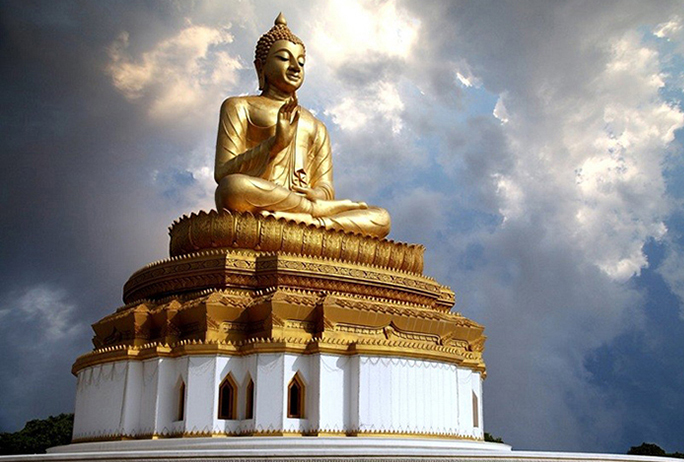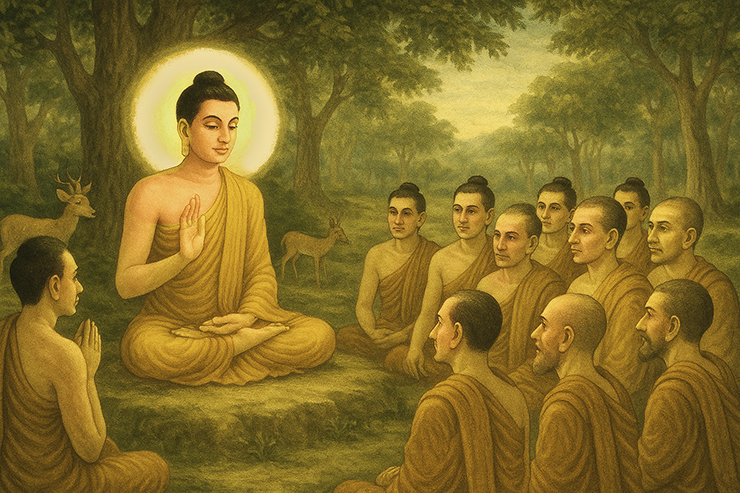SARNATH - AYODHYA - MATHURA. - VRINDAVAN - DWARKA - KASHMIR - SRINAGAR
Avataric Advents in India
Drive 10 KM Varanasi to Sarnath
Buddhas' Sarnath
Drive 18 min, plus traffic! (9.5 km) via Varanasi Cantt Overbridge from Varanasi.
When the Buddha attained enlightenment in Ceylon, he soon resolved to share his realization with others. He set out to find his five former companions—those with whom he had practiced severe austerities. He found them in a place known as Isipatana, later called the Deer Park, near Sarnath, close to Varanasi (Kashi or Benares).
The actual Deer Park at Sarnath was said to have been set aside or granted for the Buddha's use by a local raja—possibly King Bimbisara of Magadha or another regional figure with jurisdiction over the area.
-----------------------------------------------------------------------------------
The site is now marked by numerous monuments, including the Dhamek Stupa, which is believed to mark the spot where Buddha gave his first sermon.
The advent of Buddha around 650 BCE, after the Aryans had already settled in India, became the dominant religion of India. About 200 years after Buddhas' passing, Buddhism gained prominence as the significant religion in India. Over time, the decline of Buddhism, partly due to invasions by the Mughals, allowed Hinduism to resurface and become the dominant religion in India. Presently, India's religious majority follows Hinduism (around 80%), followed by Islam (15%), and other religions such as Christianity, Sikhism, Jain and others (5%).
The story of The Buddha. 650 BC. Sarnath remained abandoned until 1834 when Alexader Cunningham excavated the site. Buddha was born in Lumbini, (now Nepal) into a royal Hindu family. He renounced his birthright, followed established religious teachers, and then achieved enlightenment after striking out on his own. He was awakened to who He was while meditating under a Bodi tree located in Ceylon. He returned to India and established His ashram in Sarnath. The area was known as a deer park. The teachings delivered by the Buddha at Sarnath revolved around the Four Noble Truths, the Eightfold Path, and the Middle Way. These teachings form the core principles of Buddhism and have had a profound impact on the development and spread of the religion.

Shravasti, the ancient capital of the Kosala kingdom, holds a special place in the life of Gautama Buddha. After attaining enlightenment, the Buddha spent 25 of his 45 teaching years in Shravasti—more than in any other location. It became one of the key centers of early Buddhism.Shravasti represents the mature phase of the Buddha’s teaching life, where his Sangha flourished and many laypeople achieved high spiritual attainments. He primarily stayed at Jetavana Monastery, donated by the wealthy merchant Anathapindika. Ruins of Jetavana Monastery are still visible today, including the Gandhakuti (Buddha’s hut). Lucknow to Shravasti: Buses or shared taxis can be taken from Lucknow (175km) to Shravasti. Alternatively, the train to Payagpur followed by a short (33km) road trip to Shravasti. It is an almost 3 hour drive north from Ayodhya.
The Buddha's "Eightfold Path to Enlightenment"
-
Right Understanding: Understanding of the Four Noble Truths - the truth about suffering, its cause, its cessation, and the path leading to its cessation.
-
Right Intention: To control our actions, cultivating intentions of renunciation, goodwill, and harmlessness, as opposed to intentions governed by desire, ill-will, and harm.
-
Right Speech: Speaking truthfully, avoiding slander, gossip, and harsh language. Communicating in a truthful, positive, and constructive manner.
-
Right Action: Acting ethical and moral. It involves abstaining from harming others, stealing, sexual misconduct.
-
Right Livelihood: Earning a living that does not cause harm and is ethically positive. Avoiding professions that harm others.
-
Right Effort: Cultivating a positive state of mind:. It's a commitment to mental improvement.
-
Right Mindfulness: Being aware and attentive to our thoughts, feelings, body, and states of mind. Being present in the moment, aware of our actions and thoughts.
-
Right Concentration: Meditation practices, which develop concentration, clarity, emotional positivity, and a calm view of the true nature of things.

Carved statue of Lord Buddha in the archeological museum.
Buddhism expanded in India in the centuries after the death of the Buddha, particularly after receiving the royal support of the Maura Empire. It spread even beyond India to Central Asia and China. The consolidation of monastic organisations made Buddhism the centre of religious and intellectual life in India.
Harwan is located in the Kashmir Valley, an area known for its rich history and cultural heritage. This region played a significant role in the spread of Buddhism to Central Asia and East Asia. The monastery ruins at Harwan is significant for having been a prominent center of Buddhist learning and culture.

Sarnath remained abandoned until 1834 when Alexader Cunningham excavated the site.
Lion Capital of Ashoka: is now the National Emblem of India, is an important archaeological artifact found at Sarnath. Presently one can visit the archeological museum and walk around the Stupa. There are numerous Buddhist Temples in Sarnath. No written records about Gautama were found from his lifetime or from the one or two centuries thereafter. A complete picture of the life of Siddhartha Gautama are a variety of different, and sometimes conflicting, traditional biographies from a later date
. The Chaukhandi Stupa commemorates the spot where the Buddha met up with his first five disciples. The Sarnath Archeological Museum houses the famous Lion Capital of Ashoka, which miraculously survived its 45-foot drop to the ground, and became the State Emblem of India and national symbol on the flag of India. The museum also houses the original 5th-century CE sandstone sculpture of Buddha Preaching his First Sermon. Buddha died of dysentery. M.B.quote: His “medicine” for the spiritual bimaries (illnesses) of mankind holds the field to this day." Countries in which Buddhism is a major religion have established temples and monasteries in Sarnath ("Lord of the Deer") surrounding Buddhas place in Sarnath, the holiest Buddhist site in the world.
The modern Mulgandha Kuty Vihara is a temple constructed by the Maha Bodi Society. Dharmapala was a Sri Lankan Buddhist monk who was instrumental in the revival of Buddhism in India after it had been virtually extinct in that country for seven centuries.The temple contains a gilded replica of a 5th-century CE sculpture of Buddha Preaching his First Sermon. Its interior walls are extensively decorated with frescoes by Japanese artist Kosetsu Nosu, depicting important events in the life of the Buddha... A standing Buddha statue is located on the grounds of the Thai temple and monastery at Sarnath... Anagarika Dharmapala Museum, located on Dharmapala Road...
Hindu Synthesis and Decline of Buddhism: The period between 500 BCE to 300 AD indeed saw the composition of epics like the Mahabharata and the Ramayana, and the Puranic literature, which contributed to the development of Hinduism. The decline of Buddhism as a dominant religious force in India during this period allowed Hinduism to gain more prominence.

Temples of Cambodia, China, Japan, Korea, Myanmar, Sri Lanka, Thailand, Tibet, and Vietnam.
THE 5 AVATAR ADVENTS IN INDIA
SARNATH HOTELS: WITH ELEVATORS
Hotel The Fern Residency TC Easy reach, main road. Away from the hustle and bustle of the city. Very near the Buddha stupa. The rooms were largE. AC, large beds. The bathroom with excellent fixtures, separate shower & bathtub areas. Hot water. Hotel is very calm and soothing. Cilantro Restaurant serves Indian, Western and Chinese. (lots of weddings and events). Good room service. A nice modern hotel .
Hotel Buddha: Easy reach in Sarnath, rooms that are accessible by elevator. The hotel also has a restaurant, 24-hour front desk, and free Wi-Fi.
Hotel Deva Inn: This hotel is located in Sarnath and offers rooms that are accessible by elevator. The hotel also has a restaurant, 24-hour front desk, and free Wi-Fi.
FROM SARNATH: AFTERNOON TRAIN TO FAIZABAD. WHICH IS 8 KM FROM AYODHYA .DRIVE IS ABOUT 4+ HOURS. THERE ARE NICE HOTELS IN FAIZABAD.
The afternoon train to Faizabad, which is next to Ayodhya, takes 4+ hours from Sarnath. There are many nice hotels in Faizabad.. A few hotels in Ayodya too. It is also a 2.5 hour drive to Faizabad from Lucknow.
|
| |
|













